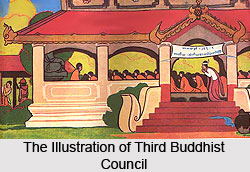 The Third Buddhist council was summoned in approximately 250 BCE at Asokarama in Pataliputra, apparently under the sponsorship of Emperor Ashoka. The reason for convoking the Third Buddhist Council is reported to have been to relieve the Sangha of corruption and fake monks, who held heretical views. It was presided over by the Elder Moggaliputta Tissa and the Council witnessed a footfall of one thousand monks. However, the council is unreputed and unknown to all Buddhist sources outside the Theravada school, and its magnitude to the other schools is thus disputable. Tradition has it that Ashoka had won his throne through shedding the blood of all his father`s son`s excluding his own brother, Tissa Kumara, who eventually got ordained and reached Arahantship.
The Third Buddhist council was summoned in approximately 250 BCE at Asokarama in Pataliputra, apparently under the sponsorship of Emperor Ashoka. The reason for convoking the Third Buddhist Council is reported to have been to relieve the Sangha of corruption and fake monks, who held heretical views. It was presided over by the Elder Moggaliputta Tissa and the Council witnessed a footfall of one thousand monks. However, the council is unreputed and unknown to all Buddhist sources outside the Theravada school, and its magnitude to the other schools is thus disputable. Tradition has it that Ashoka had won his throne through shedding the blood of all his father`s son`s excluding his own brother, Tissa Kumara, who eventually got ordained and reached Arahantship.
The Theravadin account speaks about the background to the Third Buddhist Council in the following manner - Emperor Ashoka was coronated in the two hundred and eighteenth year after the Buddha`s Mahaparinibbana. At first he paid just nominal deference to the Dhamma and the Sangha and also endorsed members of separate religious sects as his father had done previously. However, all this changed when he met the devout novice-monk Nigrodha, who preached him the Appamada-vagga. Henceforth, he stopped endorsing other religious groups and his involvement in and devotedness to the Dhamma intensified. He used his colossal wealth to build, it is supposed, eighty-four thousand pagodas and viharas and to extravagantly support the bhikkhus with the four requisites. His son Mahindra and his daughter Sanghamitra were ordained and included to the Sangha.
In due course, his big-heartedness was to create grave problems within the Sangha. In time the order was broken into by many undeserving men, holding heretical views and who were attracted to the order because of the Emperor`s unselfish support and pricey offerings of food, clothing, shelter and medicine. Large numbers of treasonable, greedy men following wrong views tried to join the order but were judged unfit for ordination.
Despite this, they usurped the chance to tap the Emperor`s unselfishness for their own ends and donned robes and joined the order without having been ordained properly. As a result, respect for the Sangha lessened. When this came to light, some of the honest monks denied to hold the ordained purification or Uposatha ceremony in the company of the debauch, heretical monks.
When the Emperor heard about this, he sought to repair the situation and sent off one of his ministers to the monks with the dictation that they perform the ceremony. However, the Emperor did not give any specific orders as to what means were to be utilised to execute his command. The monks declined to obey and hold the ceremony in the company of their fake and `thieving` companions (Pali, theyya-siniv?saka).
In desperation, the furious minister progressed down the line of seated monks and drawing his sword, beheaded all of them one after the other until he came to the King`s brother, Tissa who had been ordained. The appalled minister checked the slaughter and fled the hall and reported back to the Emperor. Ashoka was deeply sorrowed and upset by what had happened and damned himself for the killings. He sought Thera Moggaliputta Tissa`s advise. He suggested that the heretical monks be expelled from the order and a third Council be convened immediately.
It was thus during the seventeenth year of Emperor Ashoka`s reign that the Third Buddhist Council was summoned. Thera Moggaliputta Tissa headed the proceedings and chose one thousand monks from the sixty thousand contributors for the traditional recitation of the Dhamma and the Vinaya, which continued for nine months. The Emperor himself interrogated the monks from a number of monasteries about the teachings of the Buddha. Those who entertained wrong views were endangered and expelled from the Sangha right away. The Bhikkhu Sangha was henceforth sanctified of heretics and phoney bhikkhus.




















